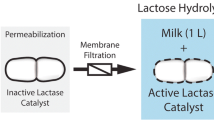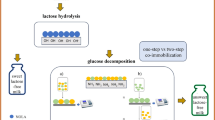Abstract
β-galactosidases, commonly referred to as lactases, are used for producing lactose-free dairy products. Lactases are usually purified from microbial sources, which is a costly process. Here, we explored the potential that lies in using whole cells of a food-grade dairy lactic acid bacterium, Streptococcus thermophilus, as a substitute for purified lactase. We found that S. thermophilus cells, when treated with the antimicrobial peptide nisin, were able to hydrolyze lactose efficiently. The rate of hydrolysis increased with temperature; however, above 50 °C, stability was compromised. Different S. thermophilus strains were tested, and the best candidate was able to hydrolyze 80% of the lactose in a 50 g/L solution in 4 h at 50 °C, using only 0.1 g/L cells (dry weight basis). We demonstrated that it was possible to grow the cell catalyst on dairy waste, and furthermore, that a cell-free supernatant of a culture of a nisin-producing Lactococcus lactis strain could be used instead of purified nisin, which reduced cost of use significantly. Finally, we tested the cell catalysts in milk, where lactose also was efficiently hydrolyzed. The method presented is natural and low-cost, and allows for production of clean-label and lactose-free dairy products without using commercial enzymes from recombinant microorganisms.
Key points
• Nisin-permeabilized Streptococcus thermophilus cells can hydrolyze lactose efficiently.
• A low-cost and more sustainable alternative to purified lactase enzymes.
• Reduction of overall sugar content.
• Clean-label production of lactose-free dairy products.






Similar content being viewed by others
References
Baltin KK, Akishev ZD, Abeldenov SK, Silayev DV, Khassenov BB (2017) Biochemical properties of recombinant Β-galactosidase from Streptococcus thermophilus. Eurasian J App Biotechnol 2:1-12
De Arauz LJ, Jozala AF, Mazzola PG, Vessoni Penna TC (2009) Nisin biotechnological production and application: a review. Trends Food Sci Technol 20:146-154
De Vos WM, Mulders JWM, Siezen RJ, Hugenholtz J, Kuipers OP (1993) Properties of nisin Z and distribution of its gene, nisZ, in Lactococcus lactis. Appl Environ Microbiol 59:213-218
Laridi R, Kheadr EE, Benech RO, Vuillemard JC, Lacroix C, Fliss I (2003) Liposome encapsulated nisin Z: optimization, stability and release during milk fermentation. Int Dairy J 13:325-336
Paul Ross R, Morgan S, Hill C (2002) Preservation and fermentation: past, present and future. Int J Food Microbiol 79:3-16
Saqib S, Akram A, Halim SA, Tassaduq R (2017) Sources of β-galactosidase and its applications in food industry. 3. Biotech 7:1-7
Chen J, Shen J, Ingvar Hellgren L, Jensen PR, Solem C (2015) Adaptation of Lactococcus lactis to high growth temperature leads to a dramatic increase in acidification rate. Sci Rep 5:1-15. https://doi.org/10.1038/srep14199
De Carvalho CCCR (2017) Whole cell biocatalysts: essential workers from nature to the industry. Microb Biotechnol 10:250-263. https://doi.org/10.1111/1751-7915.12363
De Carvalho CCCR (2011) Enzymatic and whole cell catalysis: finding new strategies for old processes. Biotechnol Adv 29:75-83. https://doi.org/10.1016/j.biotechadv.2010.09.001
Dekker PJT, Koenders D, Bruins MJ (2019) Lactose-free dairy products: market developments, production, nutrition and health benefits. Nutrients 11:1-14. https://doi.org/10.3390/nu11030551
Deng Y, Misselwitz B, Dai N, Fox M (2015) Lactose intolerance in adults: biological mechanism and dietary management. Nutrients 7:8020-8035. https://doi.org/10.3390/nu7095380
Duetz WA, Van Beilen JB, Witholt B (2001) Using proteins in their natural environment: potential and limitations of microbial whole-cell hydroxylations in applied biocatalysis. Curr Opin Biotechnol 12:419-425. https://doi.org/10.1016/S0958-1669(00)00237-8
Greenberg NA, Mahoney RR (1982) Production and characterization of β-galactosidase from Streptococcus thermophilus. J Food Sci 47:1824-1835. https://doi.org/10.1111/j.1365-2621.1982.tb12891.x
Hols P, Hancy F, Fontaine L, Grossiord B, Prozzi D, Leblond-Bourget N, Decaris B, Bolotin A, Delorme C, Ehrlich SD, Guédon E, Monnet V, Renault P, Kleerebezem M (2005) New insights in the molecular biology and physiology of Streptococcus thermophilus revealed by comparative genomics. FEMS Microbiol Rev 29:435-463. https://doi.org/10.1016/j.femsre.2005.04.008
Hutkins RW, Morris HA (1987) Carbohydrate metabolism by Streptococcus thermophilus: a review. J Food Prot 50:876-884. https://doi.org/10.4315/0362-028x-50.10.876
Hutkins RW, Ponne C (1991) Lactose uptake driven by galactose efflux in Streptococcus thermophilus: evidence for a galactose-lactose antiporter. Appl Environ Microbiol 57:941-944. https://doi.org/10.1128/aem.57.4.941-944.1991
Ishizaki A, Osajima K, Nakamura K, Kimura K, Hara T, Ezaki T (1990) Biochemical characterization of Lactococcus lactis IO-1 whose optimal temperature is as high as 37°C. J Gen Appl Microbiol 36:1-6. https://doi.org/10.2323/jgam.36.1
Israelsen H, Madsen SM, Vrang A, Hansen EB, Johansen E (1995) Cloning and partial characterization of regulated promoters from Lactococcus lactis Tn917-lacZ integrants with the new promoter probe vector, pAK80. Appl Environ Microbiol 61:2540-2547. https://doi.org/10.1128/aem.61.7.2540-2547.1995
Lin B, Tao Y (2017) Whole-cell biocatalysts by design. Microb Cell Factories 16:1-12. https://doi.org/10.1186/s12934-017-0724-7
Liu J, Chan SHJ, Chen J, Solem C, Jensen PR (2019) Systems biology - a guide for understanding and developing improved strains of lactic acid bacteria. Front Microbiol 10:1-19. https://doi.org/10.3389/fmicb.2019.00876
Liu J, Dantoft SH, Würtz A, Jensen PR, Solem C (2016) A novel cell factory for efficient production of ethanol from dairy waste. Biotechnol Biofuels 9:33. https://doi.org/10.1186/s13068-016-0448-7
Miller J (1972) Experiments in molecular genetics. Cold Spring Harbor Laboratory 466
Misselwitz B, Butter M, Verbeke K, Fox MR (2019) Update on lactose malabsorption and intolerance: pathogenesis, diagnosis and clinical management. Gut 68:2080-2091. https://doi.org/10.1136/gutjnl-2019-318404
Mulligan CN, Safi BF, Groleau D (1991) Continuous production of ammonium lactate by Streptococcus cremoris in a three-stage reactor. Biotechnol Bioeng 38:1173-1181
Nickerson TA (1957) Lactose crystallization in ice cream. III. Mode of action of milk powder in preventing sandiness. J. Dairy Sci 40:309-313. https://doi.org/10.3168/jds.S0022-0302(57)94478-8
Nijpels HH (1981) Lactases and their applications, in: Enzymes and food processing. https://doi.org/10.1007/978-94-011-6740-6_6
Panesar PS, Panesar R, Singh RS, Kennedy JF, Kumar H (2006) Microbial production, immobilization and applications of β-D-galactosidase. J Chem Technol Biotechnol 81:530-543. https://doi.org/10.1002/jctb.1453
Regenstein JM, Chaudry MM, Regenstein CE (2003) Halal food laws. Compr Rev Food Sci Food Saf 2:111-127. https://doi.org/10.1111/j.1541-4337.2003.tb00018.x
Ribeiro Júnior JC, de Oliveira AM, de Silva F, G, Tamanini R, de Oliveira ALM, Beloti V (2018) The main spoilage-related psychrotrophic bacteria in refrigerated raw milk. J Dairy Sci 101:75-83. https://doi.org/10.3168/jds.2017-13069
Shah NO, Nickerson TA (1978) Functional properties of hydrolyzed lactose: relative sweetness. J Food Sci 43:1575-1576. https://doi.org/10.1111/j.1365-2621.1978.tb02546.x
Shen J, Chen J, Jensen PR, Solem C (2019) Sweet as sugar - efficient conversion of lactose into sweet sugars using a novel whole-cell catalyst. J Agric Food Chem 67:6257-6262. https://doi.org/10.1021/acs.jafc.9b01529
Shin KC, Sim DH, Seo MJ, Oh DK (2016) Increased production of food-grade d -tagatose from d -galactose by permeabilized and immobilized cells of Corynebacterium glutamicum, a GRAS host, Expressing d-Galactose Isomerase from Geobacillus thermodenitrificans. J Agric Food Chem 64:8146-8153. https://doi.org/10.1021/acs.jafc.6b03588
Somkuti GA, Dominiecki ME, Steinberg DH (1998) Permeabilization of Streptococcus thermophilus and Lactobacillus delbrueckii subsp. bulgaricus with ethanol. Curr Microbiol 36:202-206. https://doi.org/10.1007/s002849900294
Somkuti GA, Steinberg DH (1994) Permeabilization of Streptococcus thermophilus and the expression of beta-galactosidase. Enzym Microb Technol 16:573-576. https://doi.org/10.1016/0141-0229(94)90121-X
Virolainen N, Guglielmetti S, Arioli S, Karp M (2012) Bioluminescence-based identification of nisin producers - a rapid and simple screening method for nisinogenic bacteria in food samples. Int J Food Microbiol 158:126-132
Zadow JG (1986) Lactose hydrolysed dairy products. Food Technology in Australia 38:460-462
Zendo T, Yoneyama F, Sonomoto K (2010) Lactococcal membrane-permeabilizing antimicrobial peptides. Appl Microbiol Biotechnol 88:1-9. https://doi.org/10.1007/s00253-010-2764-3
Zolnere K, Ciprovica I (2017) The comparison of commercially available ß-galactosidases for dairy industry: review. Res Rural Dev 1:215-222. https://doi.org/10.22616/rrd.23.2017.032
Acknowledgments
We acknowledge Sacco Srl., Italy, for providing strains.
Funding
This work was supported by the China Scholarship Council (Grant No. 201706300117), the DTU PoC Fund (“Sweet as Sugar” project), the Danish Dairy Research Foundation (Optimering af smagsdannelse i hårde oste), and Innovation Fund Denmark (Grant No. 6150-00036B).
Author information
Authors and Affiliations
Contributions
PRJ, CS, JL, and MF conceived and designed research. QW and HX conducted experiments. SKL and SMR contributed dairy waste materials. CS, JL, and QW analyzed data and wrote the manuscript. All authors read and approved the manuscript.
Corresponding authors
Ethics declarations
Conflict of interest
The authors declare that they have no conflict of interest.
Ethical approval
This article does not contain any studies with human participants or animals performed by any of the authors.
Additional information
Publisher’s note
Springer Nature remains neutral with regard to jurisdictional claims in published maps and institutional affiliations.
Rights and permissions
About this article
Cite this article
Wang, Q., Lillevang, S.K., Rydtoft, S.M. et al. No more cleaning up - Efficient lactic acid bacteria cell catalysts as a cost-efficient alternative to purified lactase enzymes. Appl Microbiol Biotechnol 104, 6315–6323 (2020). https://doi.org/10.1007/s00253-020-10655-3
Received:
Revised:
Accepted:
Published:
Issue Date:
DOI: https://doi.org/10.1007/s00253-020-10655-3




